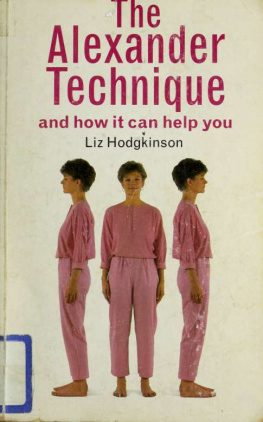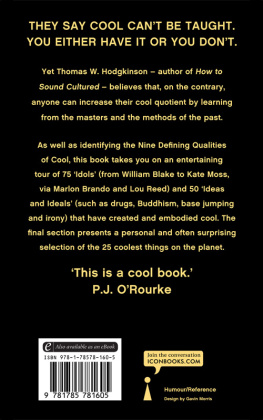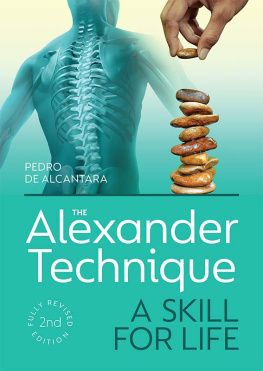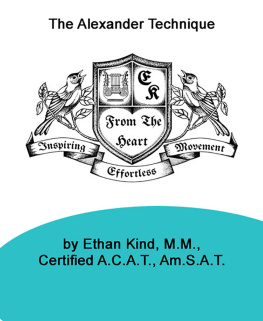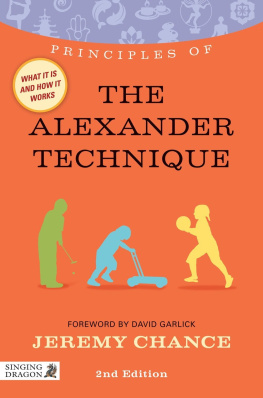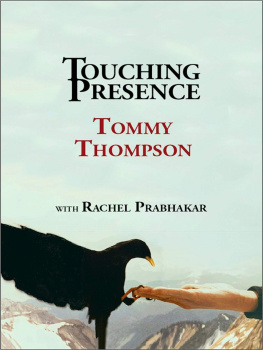Liz Hodgkinson - The Alexander technique
Here you can read online Liz Hodgkinson - The Alexander technique full text of the book (entire story) in english for free. Download pdf and epub, get meaning, cover and reviews about this ebook. year: 1988, publisher: Piatkus, genre: Religion. Description of the work, (preface) as well as reviews are available. Best literature library LitArk.com created for fans of good reading and offers a wide selection of genres:
Romance novel
Science fiction
Adventure
Detective
Science
History
Home and family
Prose
Art
Politics
Computer
Non-fiction
Religion
Business
Children
Humor
Choose a favorite category and find really read worthwhile books. Enjoy immersion in the world of imagination, feel the emotions of the characters or learn something new for yourself, make an fascinating discovery.
- Book:The Alexander technique
- Author:
- Publisher:Piatkus
- Genre:
- Year:1988
- Rating:5 / 5
- Favourites:Add to favourites
- Your mark:
- 100
- 1
- 2
- 3
- 4
- 5
The Alexander technique: summary, description and annotation
We offer to read an annotation, description, summary or preface (depends on what the author of the book "The Alexander technique" wrote himself). If you haven't found the necessary information about the book — write in the comments, we will try to find it.
The Alexander technique — read online for free the complete book (whole text) full work
Below is the text of the book, divided by pages. System saving the place of the last page read, allows you to conveniently read the book "The Alexander technique" online for free, without having to search again every time where you left off. Put a bookmark, and you can go to the page where you finished reading at any time.
Font size:
Interval:
Bookmark:

This book made available by the Internet Archive.






Digitized by the Internet Archive in 2015
https://archive.org/details/alexandertechniqOOIizh^O
Dedication
This book is gratefully dedicated to Lilian Carpenter
Introduction
Over the past few years the Alexander Technique has become one of the most popular alternative therapies, with specialised clinics and treatment rooms being set up all over the country. But, you may ask, what exactly is the treatment? How does it work? And why has it become so very popular?
I'll answer the last question first, because it is the easiest. The Technique is popular quite simply because it works - and it has stood the test of time. It was formulated almost loo years ago by an Australian actor named Frederick Matthias Alexander.
The Alexander Technique is basically a series of physical movements designed to correct bad posture and bring the body back into alignment, thus helping it to function efficiently, as nature intended. The Technique can be used to alleviate a variety of mental, emotional and physical conditions. Most often it is used for complaints which ordinary medical treatment cannot seem to help. People may consult an Alexander teacher if they suffer from bad backache, rheumatism, arthritis, asthma, or depression - and have already tried treatments suggested by their doctor. The idea is that, once you have learned to move your muscles and joints correctly, various ills of the body caused by wrong movement can then start to right themselves. The Technique is necessary, and has become popular, because the vast majority of us move our bodies wrongly - often without realising that we are doing so, until health problems arise.
The Alexander Technique \
Consequence of bad habits
Although the Alexander Technique is primarily a physical therapy, it has little to do with simple keep-fit or relaxation. Rather, it consists of unlearning bad habits which may have been acquired over many years of daily use. and have therefore become almost second nature. It seeks to replace wrong postures and muscular use with correct usage. A trained Alexander teacher will instruct pupils in this correct usage.
Alexander himself believed that most of humanity's ills -mental, emotional and physical - are caused by the gradual and largely unconscious acquisition of bad habits. When we are very small children, he said, we stand, move and conduct ourselves correctly. But all children learn by imitation, copying the behaviour of the adults around them. In consequence they learn to move wrongly, to sit wrongly and to conduct themselves wrongly. The vast majority of adults, Alexander believed, conduct themselves physically in ways which are far from ideal, and predispose the body to illness and malfunctions of various kinds. Most adults, he stated, have terrible posture, and put the wrong kind of effort into every physical action.
Alexander teachers estimate that by adolescence, about 90 per cent of us ha\ e got into bad habits of walking, sitting and standing that have become so ingrained they feel natural -and most of us cannot imagine any other way of doing things.
Unfortunately, the longer a bad habit persists, the more difficult it becomes to break, and the danger is that as we gradually acquire wrong ways of walking, sitting or even speaking, our bodies will become deformed. For many years, this deformity may not be noticed, then suddenly, there will be a twinge, or perhaps an agonising backache. Only then may we realise that something is wrong. The kind of deformity which comes gradually is usually very apparent by old age, but the bent posture and crooked backs of many elderly people are not inevitable consequences of growing old - just warnings of what can happen, if we do not take care.
By the stage that bad backache has become a problem, there is not much point in going to the doctor for pills. Although these may alleviate the pain, they do not constitute
Introduction
a cure. The problem will continue to get worse because pills cannot undo the bad habits of a lifetime. The only way to get better, say Alexander teachers, is to unlearn the bad habit, by substituting a good one.
How the Technique works
An Alexander teacher will ask her pupil to perform certain ordinary, everyday actions, such as sitting, standing, and walking across the room. As the pupil sits, stands and walks, the teacher will observe closely what is happening. She will then instruct the pupil how to sit down, to stand, and to walk in the correct way - the way in which the body was designed by nature to behave.
At first, the pupil may not be able to do as the teacher instructs. Bad postural habits can set in very early in life, even at the age of five or six. So by the time a 40-year-old adult with excruciating backache comes for Alexander lessons, there may be 35 years of wrong posture to correct.
The Alexander Technique can only start to work when a pupil begins to Teel the difference'. With practice, the correct posture can be attained, and maintained, and good habits start to take the place of the bad ones. Then the chronic health problem can begin to clear up.
Although the Technique is primarily physical, it can also help all kinds of mental conditions. Alexander believed that all humans hold emotional states within their bodies. Therefore, if you can correct the physical imbalance, he reasoned, you also stand a chance of correcting the mental state which is causing unhappiness or anxiety. In this way, the Alexander Technique constitutes the complete opposite approach from, say, psychoanalysis, or Freudian therapy.
Instead of working on the mind, the Alexander teacher works on the body. The idea behind this is that it is basically fear, anxiety, tension and stress which make people adopt wrong postures in the first place. For example, somebody who is nervous and afraid, or lacking in self-confidence may walk around slightly stooped or with the head hunched in their shoulders, as if to hide themselves. Even quite small children may do this. Or, a person who is very angry may put far more
The Alexander Technique
effort into every action than is really needed. In time, chronic anger will have a physical effect, so that overdoing actions will become normal, and natural.
Alexander believed that many human characteristics are simply learned habits, rather than innate aspects; and every time we perform an everyday action wrongly, we deepen the habit still further. One example of this is stammering, an affliction which is notoriously difficult to cure. People stammer, said Alexander, not because there is anything wrong with their vocal cords, but because they have got into the habit of stammering. As people use speech all the time, it is difficult to break the stammering habit, once it has set in.
The more often we have to perform any action, the more difficult it becomes to correct. We can see this easily in everyday life. Every day, we all perform actions that are repeated so often we never even think about them. Just reflect for a minute on how you sit. Do you just plonk yourself into a chair? Do you automatically cross your legs? Do you do anything special with your hands? The chances are, you just don't know.
Font size:
Interval:
Bookmark:
Similar books «The Alexander technique»
Look at similar books to The Alexander technique. We have selected literature similar in name and meaning in the hope of providing readers with more options to find new, interesting, not yet read works.
Discussion, reviews of the book The Alexander technique and just readers' own opinions. Leave your comments, write what you think about the work, its meaning or the main characters. Specify what exactly you liked and what you didn't like, and why you think so.

